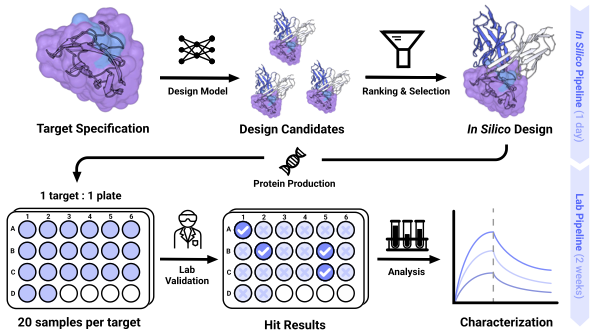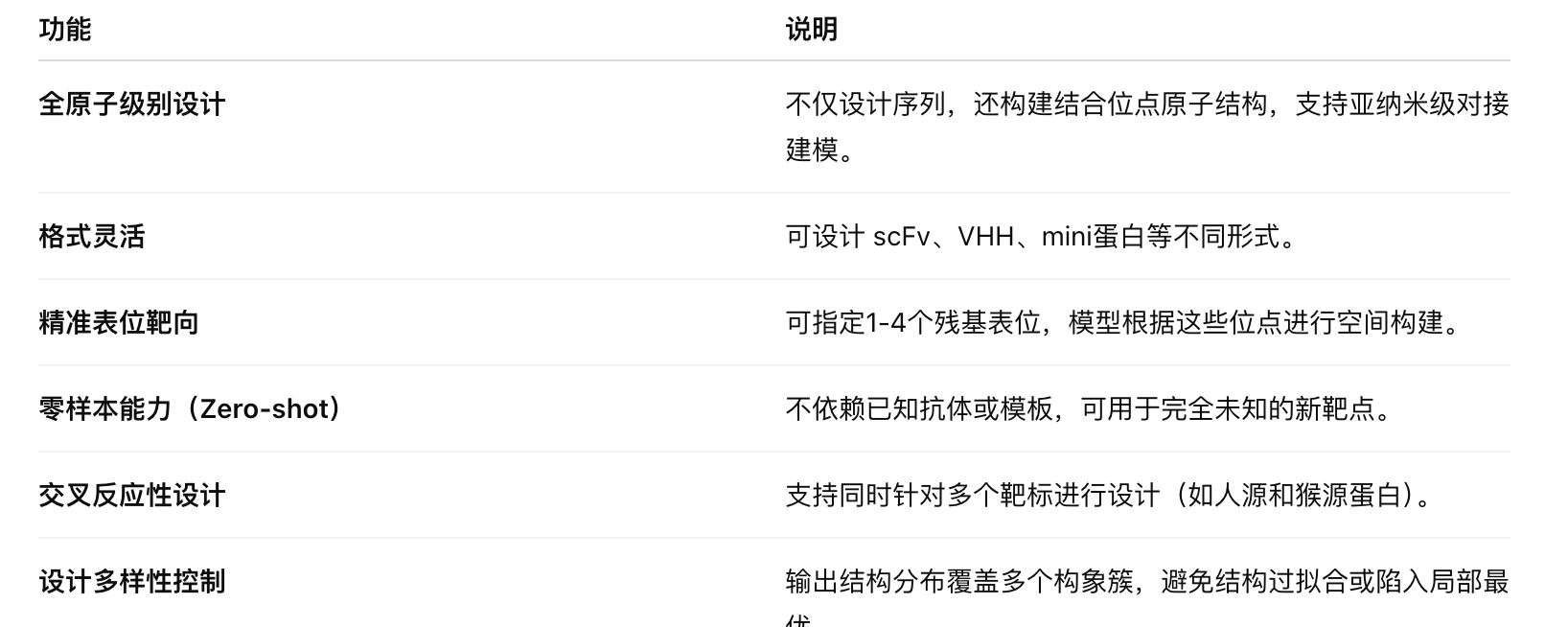- Chai-2 model
- # model structure
- # supports multiple design formats
- Activate bright
- Experimental results and evaluation
- # # antibody design mission
- Mini-protein design mission
- Why do they have such a high success rate?
- Let’s give a few examples:
- What else do they do to ensure that the antibodies are “reliable”?
-
Traditional antibodies have found that they rely on animal immunization or large-scale library screening, are inefficient, costly and ineffective for some hard-core targets.
-
Existing AI antibody design methods (e.g. RFdiffusion) are generally below 0.1% hit rate (hit rate) and difficult to separate from high flux screening.
The Chai Discovery team released a new AI model called Chai-2 for the design of antibody molecules (** antibody is used to combat the pharmaceutical composition of viruses, cancers, etc.)** which is a special protein commonly used in medicine and biotechnology. The key features of Chai-2 are zero-species learning (zero-shot) and high hit-rate design, leading to major breakthroughs in the field of antibody design. That is, the model does not require a large amount of training data input for each new antibody design target. It can understand and design a new antibody “from scratch” and it can produce an effective antibody through the knowledge available if a target protein is given. Using multi-module-generated structures, it achieves a zero-species antibody design in conjunction with atomic-grade structural prediction and modelling. Chai-2 can use only two weeks to complete a complete process from target setting to molecular generation, synthesis and validation, with a fatal rate of more than 15%, well above industry standards. The result shows that molecular engineering is moving from an empirical approach to a controlled, determinative generation strategy. ** Where is it? **
-
** There is no need for repeated experiments**: the traditional antibody design is wrong, and they can design many effective molecules with one input.
-
** Super-efficient: It could have taken months or even years to do it, and they could have done it in two weeks (exceeding 100 times).
-
** Good hit rate**: 50 targets tested and eventually more than 15% of molecules “hit” successfully, already high.
-
** 68% experimental hit rate in Miniprotein design** and picoolar affinity.
-
** AI can do it **: They use a very advanced AI system that doesn’t just understand the structure of molecules, but is designed to “think for itself”.
** Application and vision for the future**
-
It is expected that a demand-driven table-specific combination will facilitate the rapid development of complex therapies such as dual-specific antibodies, antibody drug puppets, etc.
-
Support for the design of non-traditional biological drugs such as cyclopyridium, enzymes, small molecules, etc.
-
Working towards the transformation of biology into “engineering” — moving from empirical discovery to ** controlled, programmable molecular design**.
Chai-2 model
# model structure
-
** Multimodular All-Toom General Model**
-
Two core submodules: Chai-2d: Design submodules for the direct generation of antibody sequences and structures from target proteins and tables.
-
Chai-2f: Collapse module for predicting the three-dimensional structure of proteins and assessing combined quality.
** Global Atomic Level Design**: Consider not only amino acid sequences, but also complementarities between the space structure and the atomic stages of the interface
# supports multiple design formats
-
VHH (uni-domain antibodies)
-
scFv (single-chain variable fragments)
-
Mini protein (non-antibodies but small proteins that combine the target)
Activate bright
Experimental results and evaluation
Using a one-time input of 50 targets, Chai-2 produces molecules with an experimental hit rate of over 15 per cent, the entire process takes only 2 weeks and does not require an iterative optimisation or high flux screening.

# # antibody design mission
Experimental settings:
-
52 completely new target proteins (no active antibody records)
-
Design and test up to 20 antibodies per target (scFv or VHH format)
-
Experimental method: Bio-Layer Interferomery (BLI) to determine integration capacity and filiation (KD)
-
Upgrade ** above two orders of magnitude** compared to the traditional antibody generation method (<0.1% mean rate).
-
All designs are validated only through an experimental cycle** and do not require an iterative screening.
Mini-protein design mission
-
Target number: 5 including PD-L1, IL7Ra, InsulinR, PDFBR beta and TNF alpha.
-
Experiment: 20-25 mini proteins per target designed and measured using BLI.
Examples of hits and filiation:
-
Average hit rate** > 68%**
-
TNF-α is a highly difficult-structured target designed to hit the first successful AI.
Why do they have such a high success rate?
Because Chai-2:
-
** Not only design structure, but also predict effects**: it is not a guess, but a combination of three-dimensional structure simulations and screening.
-
** Can design different types of antibodies**: include common small antibodies (scFv), camel antibodies (VHH), miniproteins, etc.
-
** Control details: The location of the target, the antibody style can be specified, and even the antibody (cross-species design) can be designed for both humans and animals.
Let’s give a few examples:
Case 1 against TNF-α (a very difficult target)
-
TNF-α has a complex structure and has never been successfully designed by AI.
-
Chai-2 designed antibody ** successfully glued to it ** and was first achieved!
Case 2: antibody “double version” design
- For the same target protein (CCL2), Chai-2 designed two antibodies (scFv and VHH) in different locations, and both succeeded **!
Case 3: Trans-species antibodies
-
Scientists allow Chai-2 to design the same protein that combines humans and monkeys.
-
The result was indeed achieved: the antibody capacity was designed to “stuck” the target protein for both species.
What else do they do to ensure that the antibodies are “reliable”?
-
One-size-fits-all examination**: Antibodies stick only to the target to which they should stick, and not to the proteins.
-
Safety indicators: AI will assess in advance whether the design is likely to trigger an immuno-response (immunosis).
-
Stability assessment: Vulnerability to variability or agglomeration is a matter of availability.
To use Chai-2, visit https://www.chaiscory.com/project Technical report: https://chaiassets.com/chai-2/paper/technical_report.pdf



